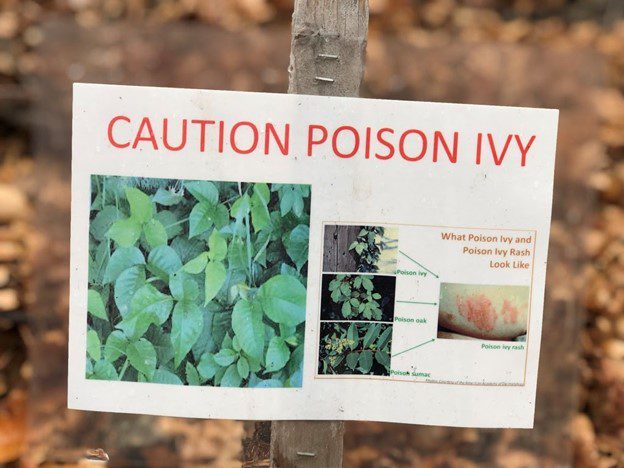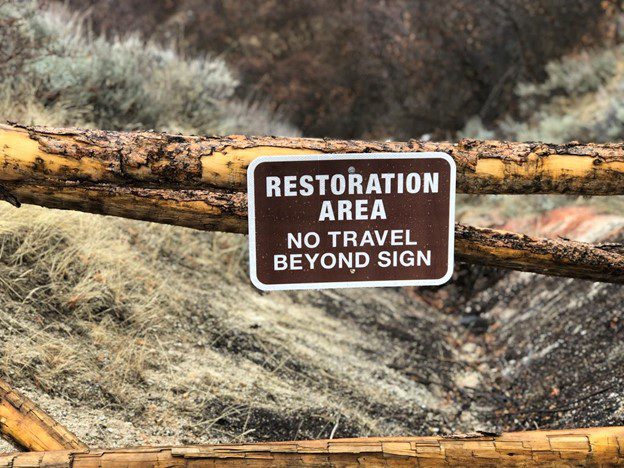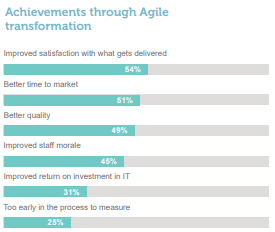Saying we want our organization to become more agile, really means we want it to create even more customer and shareholder value. Perhaps, there is a particular market or industry we want to capture, but our product isn’t able to do it well. Or, maybe we need to become more competitive. Or we’re seeing financial trends or forecasts that tell us we can’t continue to operate in the same way. Regardless, agile transformations are arduous, demanding journeys to a loftier, more effective, more value-creating state.
Is an organizational transformation even possible? The answer is a resounding “Yes!” and we’ve discovered several cairns, or trail markers, that may be helpful to your journey.
Cairn 1: Understand where you are and where you’re going

Like any journey, you need to know your starting point and destination. What are the outcomes you want? What does your organization need to become? What changes need to be made? Transformational changes can often be unclear, risky, and expensive.
Assess Where You Are
We’ve found that the first cairn for most organizations is an agile assessment. The assessment is an intense two-to-five-week review of your existing project management practices, corporate objectives, culture, and organization. The assessment provides you with a better understanding of your starting point as well as an implementation strategy and roadmap for the future. Good maps are imperative for any significant journey.
Cairn 2: Prepare for your journey
All successful journeys begin with preparation. You must consider packing lists, food, review of weather, possible terrain, and many other variables as you prepare. Preparations are for whatever may come along the way. In an agile transformation context, here are preparations we recommend.
Communicate, communicate, communicate
Help everyone in your organization understand why you are taking the transformation journey. Let them know the business outcomes you want to accomplish. Create a compelling “why” statement that will help everyone capture your vision. Then share the initial steps and how you’ll be communicating with everyone during the journey. Set expectations that the results won’t be immediately perfect, but through experimentation, inspection, and adaptation it can become better and better. Good communication is essential.

Train, train, train
Help everyone in your organization get on board. Training is critical for teaching them the new world. Help your organization to catch the vision and understand what will be required and why it’s important. Essential introductory agility courses include Certified ScrumMaster (CSM), Certified Scrum Product Owner (CSPO), and Certified Scrum Developer (CSD) courses.
Certified Agile Leadership courses are also helpful for leaders. In time, more advanced training will be necessary for scrum masters and product owners (Advanced Certified ScrumMaster (A-CSM), Advanced Certified Scrum Product Owner (A-CSPO).
Scrum masters, product owners, and developers can all eventually progress to be a Certified Scrum Professional (CSP) in their respective roles as well. Agile Essentials classes may also be offered for time-constrained executives. Training may be expensive, but it will be more expensive to not empower your organization with these critical skills and knowledge.
Remember: Starting out right by investing in training and professional coaching isn’t a cost center, it’s a profit center.
Find a guide
Finding a reliable, trustworthy guide is valuable for navigating your transformation. Coaching and mentoring enable newly trained team members to apply what they learned to the real work. Capability happens via experience, and a guide is critical for helping your organization to gain the right experience. Practice doesn’t make perfect, it makes permanent.
However, don’t confuse a guide for a pack mule. Only you can transform your organization. A good guide will show you the way but will not carry your pack. The guide provides navigation guidance, but they won’t drive for you. You’ll be responsible for selecting pilot teams, members, and projects, determining business priorities, and managing employees.

Build organizational support (ATT)
All successful transformations have executive sponsorship. Build a cross-functional team of leaders empowered to make changes in your organization. Then charge them with ensuring the agile transformation is successful. Many call this team the Agile Transition Team (ATT).
Let them lead by example, practicing scrum as they own and drive the implementation strategy and roadmap. Allow them to contribute to and own the agile vision for what the organization will become. Organizational impediments, surfaced during pilot team retrospectives, become their backlog. Sprint after sprint, the ATT improves the teams’ environment, enabling higher performance across the organization.
Grass root experimentation
Establish experimental pilot teams, one at a time. Let them apply what they learned in training. It’s okay if they make mistakes. They’ll also learn quickly. Help them see the value of early failure. Enable them to work safely with your customers as closely as you possibly can.
Through sprint reviews and retrospectives, they’ll make needed adjustments to become more effective, experiment after experiment. This grass roots growth is critical as it allows teams to focus on learning the fundamentals of agility before expanding. Grass root swelling drives healthy self-organization rather than stifling “predict, command, and control” tendencies, often exercised by management. Pilot teams help organizations learn and adapt by uncovering organizational impediments preventing success. Keep the teams stable and as permanent as possible.
Make the Agile Manifesto, 12 principles, and scrum values part of the organization’s DNA. Reference them frequently. Put up signs and reinforce demonstration of these often. Create the environment these pilot teams need, give them support, then trust them to do the job.
Maintain a 2:1 scrum team to agile coach ratio. This helps scrum masters have the support they need as they learn to become the team’s coach (preferably even 1:1 as the team learns agile fundamentals). Enable highly aligned and autonomous teams rather than “scaled” teams.
Remember: Scaling requires a solid foundation of autonomous teams with experience and understanding of how to apply agile values and principles. Scaling or making things bigger and more complex is an anti-pattern for agility.
Establish communities of practice or guilds
Create an opportunity for the organization to learn from the success of others. Empower functional managers to become talent development managers focused on building capability. Let them lead communities of practice, extending their passion across the entire organization. Community of practice experts, Wenger-Trayner, define a community of practice as:
“A group of people who share a concern or a passion for something they do and learn how to do it better as they interact regularly. This definition reflects the fundamentally social nature of human learning.”
Examples of agile communities of practice include a community of scrum masters or product owners, DevOps enthusiasts, people interested in User Experience, or even quality assurance. Opportunities for learning and improvement within a community of talented peers are endless!
Cairn 3: Start walking
Now that you know where you’re going, and you’ve prepared for your journey, the next is the first step forward.
Your example and servant leadership are critical. Lead by example in demonstrating agility. Try and fail, gather feedback, then experiment again. Practice what you expect. Be open and transparent. If you’re on a team or have a team, then use the simple and proven scrum framework for starters.
Realize that if your organization struggles with the truth, they will not like agile. Agile is a set of values and principles. It’s an empirical control method. It’s an exposure model—it exposes facts to address them. Manage by example in being truthful with yourself, your team, and organization, which will require vulnerability (even publicly).
Remember too, that the journey may be slow at first. It takes time and repetition to build new muscles. Commit to the journey, no matter how hard it gets. Be like water, continually finding a better way when barriers appear. As the agile manifesto declares, “responding to change [is valued] over following a plan.”

During a journey, momentum is everything. It’s either going forwards or backwards. To keep your momentum going forward, here are some suggestions.
Enjoy the journey
Agile transformations are people journeys. Treat people as people, not resources. Individuals and interactions are much more important than processes or tools. Customer collaboration is more important than contract negotiation. Humor is critical to successful transformations. Find ways to interject humor and enjoyment into your journey. Celebrate victories (and failures or early learnings) often!
Your best people will need plenty of rest, support, sympathy, and compassion along the way. Create an environment where they have autonomy, purpose, mastery, and belongingness.
Show customer-focused results
Help teams to accomplish customer-focused outcomes. Success yields more success. Continually ask how your transformation will improve the lives of your customers. Align sprint, release, and product goals to customer needs. Remember to welcome change, even late in development. Then harness that change for your customer’s competitive advantage (agile principle #2).
Burn the ships
Hernán Cortés, after arriving in the New World with 600 men, burned his ships to motivate their success. Likewise, identify and burn your ships. Eliminate any possibility of retreating from your vision. The following are some good examples of how to do this:
- Enable people to take new roles. However, change their titles quickly as well as the criteria used to evaluate their performance (performance reviews, etc.). Building a new scrum master with a legacy title of Sr. Business Analyst is confusing for everyone and gives space for a retreat. Be aware that people will want to know what career path opportunities are available to them as they grow in their new role. Shift over time from incentivizing individual team member goals to incentivizing team goals.
- New job postings for project directors, PMO leaders, project managers, managers, and business analysts are confusing to an organization becoming more agile. Make the decision to backfill with agile roles or accountabilities rather than traditional. Focus new roles on how they serve the customer instead of a hierarchy.
- Replace your software development life cycle (SDLC) with the team’s definition of done. Allow your teams to begin owning product quality, automation, architecture, performance, security, etc. Remove the gates and barriers to production releases. Scrum teams create “potentially shippable” product increments with production-ready quality every sprint.
- Transition your PMO from a compliance organization into an enabling organization. Shift from “managing” to bold servant leadership. Teach your teams to hold themselves accountable.
Don’t compare yourself to others
Others may be faster or slower than you. Go at a pace that makes sense for your organization. Consistent, effective effort leads to success. Several agile assessment tools exist for measuring maturity along the way. Use one.

Most importantly, don’t lose a finger!
I told the product owner of the ATT at a recent client organization he may feel a little bit like Frodo Baggins after his current transformation journey. His response was, “Wait, didn’t Frodo lose a finger?” I jokingly reassured him that loss of limb during a transformation was entirely possible, but that the journey would be worth it, and it was.
According to the Scrum Alliance, benefits of agile transformations experienced by most organizations include:
- Faster innovation
- Moving from idea to delivery more quickly
- Driving higher customer satisfaction
- Increasing employee morale
In the State of Scrum 2017-2018, which included over 2,000 respondents, 27 industries, and 91 countries, the most popular achievements were:
- Improved satisfaction with the delivered product
- Better time to market
- Better quality

Good communication, understanding where you are and where you want to go, making the necessary preparations for your journey, and having the courage to start walking with determination are keys to success. When you reach your destination, you’ll exult in your accomplishments and marvel at the amazing new view. Then, after a brief, deep breath, you’ll turn forward and say, “What’s next?”
What’s next for your organization’s agile transformation journey?
As veteran guides with over 20 years of experience, we can help you. Our highly rated training, ability to recruit top talent, and our experienced certified scrum professional (CSP+) coaches have successfully guided organizations to their desired transformational state, with all 10 fingers intact.
Use our assessments, recruiting, training, and transforming services to help you reach your transformational destination.


